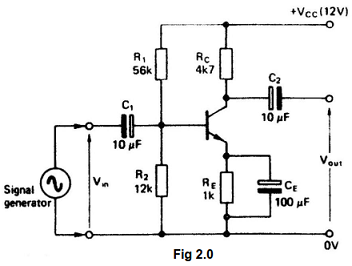Reference no: EM132449078
Assignment -
LEARNING OBJECTIVE 1: Determine the operational characteristic of amplifier circuits.
1. Describe briefly the operational characteristics of Power amplifiers class A, B and AB. State one application of each of the amplifier.
2. List the different performance characteristics of Class A, B and AB amplifiers.
3. Refer to the amplifier in Fig. The amplifier has a mid-band gain of 10 and a frequency range of 159.0 Hz to 14.5 KHz. Apply practical tests on the amplifier's performance and comment on the results.

4. Evaluate the validity of the simulation and practical results for the operational amplifier circuits against the designed criteria and identify the sources of errors.
LEARNING OBJECTIVE 2: Investigate the types and effects of feedback on an amplifier's performance.
1. Discuss briefly the types of feedback and their effect on the amplifier's performance.
2. Describe the effect of negative feedback on the CE amplifier in Fig 2.0.
3. Perform practical tests to analyse the effect of applying feedback on the CE amplifier in Fig 2.0.

4. Plot the gain/frequency response of the CE amplifier with and without feedback using Multisim and evaluate the results of practical and simulation tests to analyse the effect of feedback on the amplifier's performance.
LEARNING OBJECTIVE 3: Examine the operation and application of oscillators.
1. List the main types of oscillators and their applications.
2. Assess the performance of the oscillators in fig 3a & 3b.


3. Simulate the circuits in Fig 3.0 a & 3b and analyse the results obtained from practical and simulation results.
LEARNING OBJECTIVE 4: Apply testing procedures to electronic devices and circuits.
1. You are required to identify the appropriate manufacturer's data sheet for the following devices and circuits:
- Diodes
- Transistors
- Operational Amplifier
- Power supply circuit
- Transistor amplifier circuit
2. Interpret the relevant information from the manufacturer's data sheet when using the above devices in 1.
3. Perform tests on the above devices and circuits and recommend appropriate action.
4. Use Multisim to test the above devices and circuits and analyse and compare both the virtual and practical results.